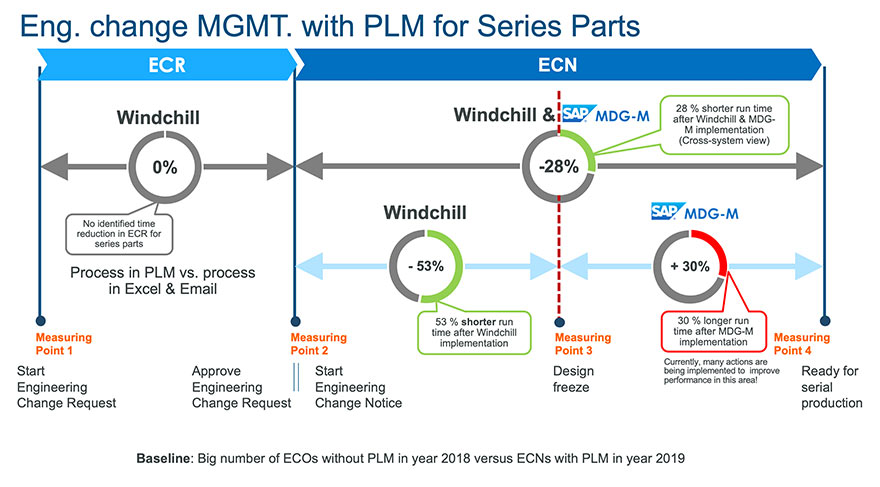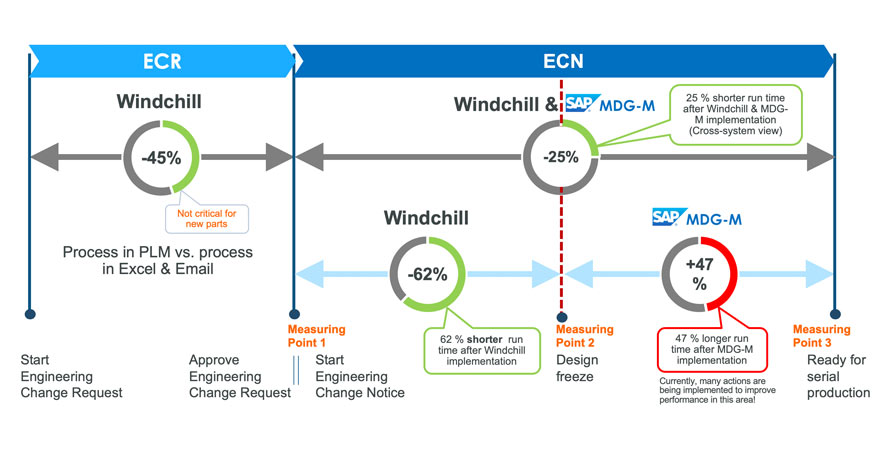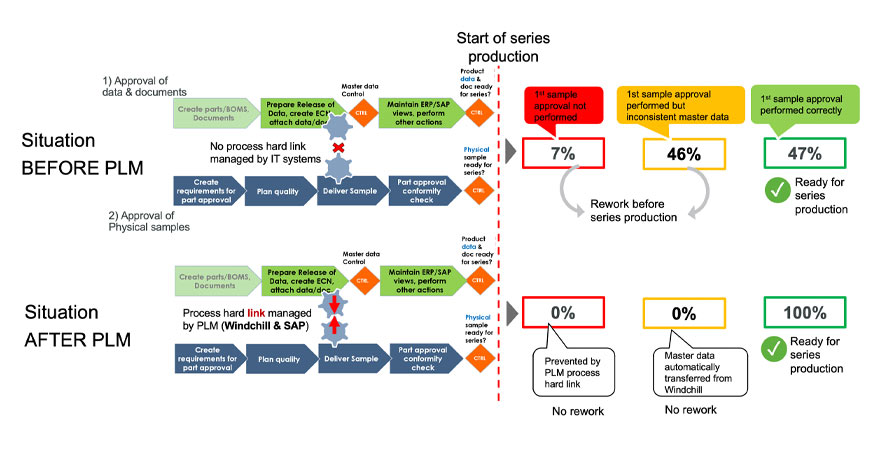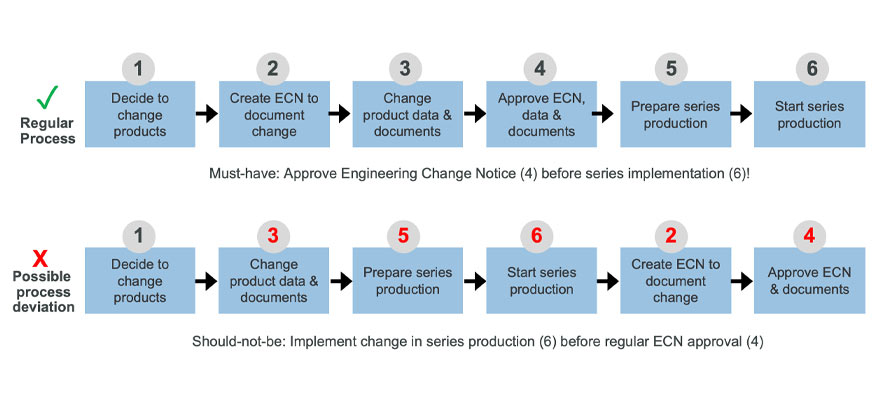The Vaillant Group, a global market and technology leader in the field of heating, ventilation, and air-conditioning (HVAC) technologies, took a long-term approach to digital transformation for the management of the product lifecycle with Windchill which is connected to SAP with a multi-layer interface. Key milestones of their eight-year PLM roadmap have been met, including functionalities that create and manage parts, BOMs, and documents in Windchill; enable product releases and change management; manage product compliance/sustainability; track product maturity; enrich SAP views through workflows and phase out products at EOL.
The Challenge
Vaillant utilizes several different design and productivity software platforms such as CAD (PTC Creo, AutoCAD, Mentor), PLM (Windchill), and ERP (SAP). Initially, the Windchill to SAP interface did not exist. Process and data management tasks were manually handled through a combination of spreadsheets and emails. Maturity and approval status of product BOMs, 3D CAD models, 2D CAD drawings, technical specifications and other documents were tracked manually with high effort. Manual search for documents and information within documents was difficult and inefficient. ECNs were managed in Excel, and the ECN data must be transferred to ERP again by manual entry.
System-controlled hard links between release of product data, its first physical sample and necessary workflow did not exist leading to high effort to manage manually.
There were many drawbacks to this approach: inadequate access-control, lack of concurrent engineering functionality, high efforts for spreadsheet handling, lack of traceability and version control, lack of transparency & status tracking, long waiting times to finish process steps, and a flawed error-prone manual data entry process. The result was slower time to market and higher levels of rework.
These issues were confirmed by an independent consultant (Ernst & Young) after an extensive analysis and evaluation process. The results of which precipitated a digital transformation project for the management of product lifecycle that spans a ten-year phased approach, with deliverables in three phases.
The Solution
Phase I
This phase, 2015–2017, focused on the core elements of PLM such as workflow-controlled creation of parts and Bill of Materials (BOM), concept and pilot for release and engineering change management and first physical sample release process as well, management of product documents, concept of product maturity status “from cradle to grave”, automatic transfer of product data from Windchill to SAP, workflow-controlled enrichment of SAP views and other product creation related activities after Design Freeze.
Phase II
IIn the second phase, 2018–2021 (planned) of the roadmap, advanced PLM functionalities are added to the PLM roadmap mainly to manage the entire process to collect, consolidate, approve and test product requirements, to manage and track product compliance/sustainability, to manage product costs during developments and to manage a product phase out as well. The world-wide productive use of release and engineering change management and first physical sample release process is a part of this phase as well. In addition, the use for model-based system engineering is drafted.
Phase III
In the final phase, 2022–2024 (estimated), after the delivery of PLM basic and advanced functionalities, Vaillant plans to close the information loop between phases of the product lifecycle by applying digital transformation technologies. For example, they plan on using connected product information acquired from IoT (Internet of Things) sensors to predict failures and optimize new and existing products through fielded product input to design. They also plan to provide service departments with AR (augmented reality) work instructions for improved service delivery, create and apply Digital Twins for different use cases etc. All these uses cases need to be described and evaluated together with relevant users and stakeholders in order to ensure the added value.
The Result
ECN Before PLM
For Vaillant, managing ECNs before the implementation of a PLM solution was fraught with process issues and inefficiency. They faced a multitude of key challenges: high-setup times (involving manual data collection of changes), non-transparent change statuses, long process execution times, time-consuming manual tracking of actions needed for ECN implementation, and reliant on phone and email.
ECN After PLM
When Windchill’s high configurable out-of-the-box PLM capabilities with a multilayer interface to SAP/MDG-M are applied to this process, a holistic change management solution takes place, and provides the following immediate benefits:
- Lists with interdependent parts, products, documents, etc., are automatically generated
- Critical functions such as pre-defined rules are automatically generated
- Automatic transfer of changed product data, including manufacturing BOM, to ERP SAP (via Enterprise Systems Integration, ESI)
- Enhanced and efficient workflow-controlled approval processes
- Workflow functionalities provided by Windchill and SAP MDG-M
- Automatic and transparent cross-systems status tracking of changes
- And more…
Workflow Management Improvements
Vaillant defined the following three concrete ECN measuring points in the process both before and after PLM.
Creation date of ECNs in Windchill with integration to SAP versus the manual process in Excel (before PLM) Date of Design Freeze in Windchill versus manual process in Excel (before PLM) Effectivity dates of engineering changes (ECNs) before and after PLM, meaning that parts/products are ready for series production
For Engineering Change Request Process (ECR) which is significant for the modification of parts in series, not for NPI, the following three concrete ECR measuring points in the process both before and after PLM.
- Creation date of ECRs in Windchill versus the manual process in Excel (before PLM)
- Date of ECR Approval in Windchill versus manual process in Excel (before PLM)
The key metric here is the reduction in processing time to implement an engineering change owing to the benefit of PLM. From January 2018 – December 2018, Vaillant was measuring the average time to process engineering changes having a valid-from date within this time window. When that same metric was tested after they implemented PLM consequently for the ECN process from January 2019 – December 2019, the average process run time reduction was ~ 25% by the end of 2019. The measurement includes Windchill and SAP MDG-M as well.
The performed run time measurements have been cumulated in order to gain realistic and actual results. This means that, the arithmetic average of process run time was calculated for all ECNs during the first Quarter 2018 (without PLM) and compared with all ECNs during first Quarter 2019 (with PLM). The following measurement step considered all ECNs in Quarter 1 and Quarter 2 in 2018 (without PLM) compared to all ECNs in Quarter 1, and Quarter 2 in 2019 (with PLM), and so on.

Figure 1: ECN for NPI (Release/Launch of New Parts)
A deep dive into the active workflow systems applied for the ECN process shows a significant run time reduction where Windchill is applied. On the other hand, the process part running in SAP MDG-M indicates a gap between expected and real process run time reduction. Many promising activities have been defined and either launched or currently being implemented to improve the situation.

Figure 2: ECN for Modification of Series Parts
Besides PLM workflow benefits, there is another significant aspect which could be noticed before and after PLM. While big ECNs containing a lot of BOMs, drawings, and other documents have been often used before PLM to release new products; the situation after PLM has changed. The people use now smaller ECNs and start the process on the right time leading to shorter process run times and a better planning.
Process to Improve First-Pass Yields
Before parts or products flow into series production, two important approvals—besides others—must be carried and should be aligned with each other:
- Approval of product data and documents: This process is managed with the ECN process (Engineering Change Notice) ensuring that all data and documents are ready for series production. The process ensures also that all necessary tasks have been carried out by production, quality, purchasing etc.
- Approval of 1st samples of parts/products: Based on product documents and data, the first physical samples of products are delivered, for example, by supplier. This control is carried out by, above all, Quality, Development, Production and Purchasing.
After the implementation of PLM, both approvals are fully controlled by PTC Windchill and SAP. There is a hard link between both approvals in PLM allowing no deviation at the start of series production.

Figure 3: Improved Process Quality of First-Pass Yield Physical Sample Approval after PLM Implementation
Improving Follow-up Documentation of ECN
Generally, a manual process for the documentation of Engineering Change Notices (ECNs) allows unwanted deviations. This was the case with ECN documentation before PLM. This situation leads to re-work before starting series production causing efficiency drop.
Now, this process is fully supported by PLM at the Vaillant group. The share of ECN follow-up documentation in 2018, where PLM was not yet applied for ECN process, was compared with 2019 where all ECNs run in PLM (Windchill and SAP MDG-M). Thousands of ECNs and ECOs have been investigated before and after PLM and the picture is worth 1000 words!
With PLM the share of ECN follow-up documentation was going down from ~50% to 2% within 12 months. This is a clear message for the ability of PLM to get processes under control and enable your engineers to have more value-added time.

Figure 5: Regular Process to Manage ECN Documentation and Possible Deviations
Improving Master Data Quality
Master data are key data assets within an organization and are the entities that describe products and drive business processes. They need to be evaluated, for instance, to measure performance. In order to achieve high quality of master data to ensure smooth business operation, they must be controlled by governance processes.
Before PLM, master data of products at the Vaillant Group have been created and maintained by R&D in different systems: 3D CAD system, PDM system, spreadsheets, text processing systems etc. This led to duplicated data, multiple data inputs, incomplete data etc. This rework caused additional effort.
After PLM, data sources where master data are maintained are connected and duplicated data have been minimized. The share of rework due to master data quality issues is decreasing after PLM and free resources can focus on innovative tasks. By the end of 2019, the share of rework has been reduced by 16% compared to 2018. As practice makes perfect, it is expected, that the situation will be continuously improving in the future.
Project Lead Time
The project lead time is the latency between the start and the completion of a project.
Reducing project lead would also lead to reduce time to market increasing the competitive advantage of a company. For product development and product management, the time to market is often a key KPI to measure work performance. The right PLM solution will help to reduce time to market.
The project lead time was measured before and after PLM. The following measuring points have been selected:
- Date of project start
- Date of product design Freeze (developed within the project)
- Date, where the product is available in the market
A huge number of projects before and after PLM have been analyzed to measure the effect of PLM on the lead time. The most significant lead time which can be affected by PLM is between “Start” and “Market Availability”. Projects run in PLM show an average reduction in the lead time “Start-to- Market Availability” of about 8% compared to projects run before PLM. Further reduction in the lead time is expected due to increasing experience with PLM in the future.
Digital Transformation
While Vaillant Group is still in the process of getting their Digital House in Order, they have come a long way already by tapping into the engineering change management process benefits that PLM inherently provides. Their short-term goal of improving efficiency from 2015 has been a real success story for Vaillant. And what is more important is that they took the time to measure and quantify the results of their efforts to bring Product Lifecycle Management into their organization.
Armed with these new metrics and results—clearly illustrating the value of PLM—the stage is set for the next level buy-in from the Vaillant Group C-Suite. What this means is that they have a great business case to continue pursuing their Phase II & Phase III plans of Digital Transformation (including technologies such as IoT and AR).
Vaillant certainly looks to the future as they strengthen their Digital Thread with new technologies to deliver even more value back to the business.
Dr. Gamal Lashin, Strategy & Performance Manager, Vaillant Group